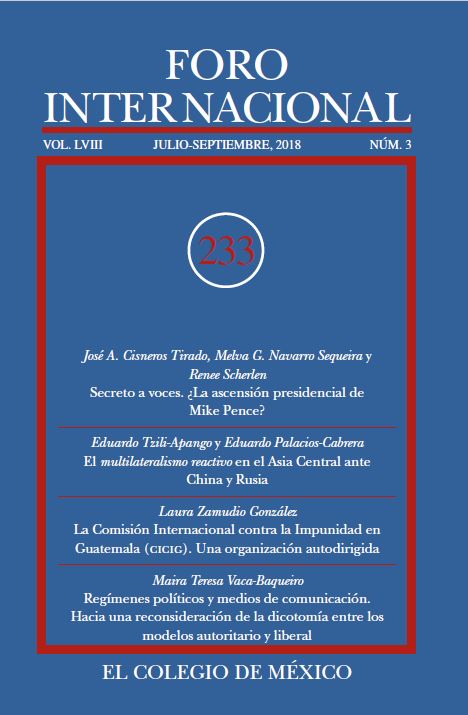Reactive Multilateralism in Central Asia Versus China and Russia.
DOI:
https://doi.org/10.24201/fi.v58i3.2463Keywords:
Central Asia, China, Russia, Multilateralism, Silk RouteAbstract
It is well known that Central Asia is one of the zones in which geopolitics acquires great importance in current international relations either because of its strategic natural resources or because it is the route that connects East Asia with West Asia and Europe. In spite of this, Central Asia has been tagged as one of the most conflictive zones given the convergence and the correlation of regional and extra-regional forces. In this line of thinking, it is argued that power imbalances caused by extra-regional powers and non-state actors have driven an institutionalization and multilateralization process executed by the regional actors since the nineties. This reactive multilateralism is an answer to extra-regional and inter-regional aftermath actions in Central Asia. Nevertheless, it also promotes the consolidation of the regional powers’ interests in the area, especially due to secure the supply of energy resources and to consolidate trade routes. In this process, China and Russia have played an important role, although without being able to establish a regional hegemony both because of the divergence in politics and interests between them and because of the presence of other actors with significant regional influence.
Downloads
References
Acharya, Amitav, “Ideas, Identity, and Institution-Building: From the «asean Way» to the «Asia-Pacific Way»?”, The Pacific Review, vol. 10, núm. 3, 1997, pp. 319-346.
J. C. Morse y R. O. Keohane, “Contested Multilateralism”, The Review of International Organizations, vol. 9, núm. 4, 2014, pp. 385-412.
Arroyo Velasco, Rosario, “China: intereses geoestratégicos en Asia Central”, en Ana Teresa Gutiérrez del Cid, Graciela Pérez Gavilán y Fernando Montiel T. (coords.), El corazón del mundo: Asia Central y el Cáucaso, México, Ariete-Montiel & Soriano Editores, 2005, pp. 131-156.
_____, “China: estrategia energética en Asia Central”, en Rosario Arroyo Velasco, Ana Teresa Gutiérrez del Cid y Graciela Pérez Gavilán (coords.), Nuevos escenarios geopolíticos: Asia central-México, México, UAM-Xochimilco-Central Asia-Caucasus Institute, 2009, pp. 235-262.
Beshimov, Baktybek y Ryskeldi Satke, “The Struggle for Central Asia: Russia vs China”, Al Jazeera, 12 de marzo, 2014, en http://www.aljazeera.com
Bhagwati, Jagdish, “Regionalism versus Multilateralism”, The World Economy, vol. 15, núm. 5, 1992, pp. 535-556.
Camroux, David, “Regionalism in Asia as Disguised Multilateralism: A Critical Analysis of the East Asia Summit and the Trans-Pacific Partnership”, The International Spectator, vol. 47, núm. 1, 2012, pp. 97-115.
Clarke, Michael, “China and the Shanghai Cooperation Organization: The Dynamics of «New Regionalism», «Vassalization», and Geopolitics in Central Asia”, en Emilian Kavalski (ed.), The New Central Asia. The Regional Impact of International Actors, Singapur, World Scientific, 2010, pp. 117-148.
_____, Xinjiang and China’s Rise in Central Asia-A History, NuevaYork, Routledge, 2011.
Dreyfuss, Robert, Devil’s game: How the United States Helped Unleash Fundamentalist Islam, Holt, Metropolitan, 2006.
Fan Haihong, “La situación geopolítica en Asia Central y su impacto en el territorio fronterizo occidental de China (中亚地缘政治态势及对中国西部边疆地区的影响), Zhongguo Shehui Kexueyuan (中国社会科学院), 25 de agosto de 2014, en http://www.cssn.cn/zzx/wztj_zzx/201408/t20140825_1302340.shtml
Fang Changping, “Multilateralismo y estrategia de la seguridad periférica de China” (多边主义与中国周边安全战略), Jiaoxue Yu Yanjiu (教学与研究), vol. 5, núm. 22, 2004.
Gutiérrez del Cid, Ana Teresa, “La nueva geopolítica euroasiática”, en Mario Alejandro Carrillo (coord.), Reflexiones finiseculares, México, UAM-Xochimilco, 2000, pp. 245-275.
_____, “Asia Central en las nuevas condiciones geopolíticas y geoeconómicas”, en Rosario Arroyo Velasco, Ana Teresa Gutiérrez del Cid y Graciela Pérez Gavilán (coords.), Nuevos escenarios geopolíticos: Asia central-México, México, UAM-Xochimilco-Central Asia-Caucasus Institute, 2009, pp. 75-100.
Han Lu, “Los avances de la Franja Económica Ruta de la Seda en Asia Central: logros y prospectivas” (丝绸之路经济带在中亚的推进:成就与前景), Guoji Wenti Yanjiu (国际问题研究), núm. 3, 16 de mayo de 2017, en http://www.ciis.org.cn/gyzz/2017-05/16/content_9484045.htm
Hemmer, Christopher y Peter J. Katzenstein, “Why Is There No nato in Asia? Collective Identity, Regionalism, and the Origins of Multilateralism”, International Organization, vol. 56, núm. 3, 2002, pp. 575-607, en http://www.aljazeera.com
Kelimbetov, Kairat, “Kairat: Kazajstán participa, activamente, en «Una Franja, Una Ruta»” (凯拉特:哈萨克斯坦积极对接“—带—路”), Renmin Wang (人民网), 18 de septiembre de 2016, en http://www.people.com.cn/n1/2016/0918/c32306-28720721.html
Khan, Simbal, “Stabilization of Afghanistan: U.S.-nato Regional Strategy and the Role of the sco”, China and Eurasia Forum Quarterly, vol. 7, núm. 3, 2009, pp. 11-15.
Kosolapova, Elena, “Construction of Tajik section of Turkmenistan-China gas pipeline starts”, Trend News Agency, 26 de julio de 2017, en https://en.trend.az/business/energy/2781353.html
Laruelle, Marlene y Sebastien Peyrouse, “Regional Organisations in Central Asia: Patterns of Interaction, Dilemmas of Efficiency” (Working paper, 10), Bishkek, University of Central Asia, 2012.
Lascurain Fernández, Mauricio, “El papel geoestratégico de Asia Central”, Foro Internacional, vol. 57, núm. 2, 2017, pp. 389-421.
Li Chunling, “«El extranjero ve las dos sesiones». «Una Franja, Una Ruta» se ha convertido en la «nueva tarjeta de presentación » de China para el mundo” (“«海外看两会» «—带—路’成为中国迈向世界舞台的’新名片»”), Xinjiang Ribao (新疆日报社主办), 7 de marzo de 2016, en http://www.xinjiangyaou.com/special/2016/009/08/1326485.shtml
Malysheva, D., “Kazajistán y Rusia: problemas de interacción” (Казахстан и Россия: проблемы взаимодействия), Ritm Yevrazii(Ритм Евразии), 8 de septiembre de 2016, en https://www.ritmeurasia.org/news--2016-09-08--kazahstan-i-rossija-problemy-vzaimodejstvija-25616 MID, “Rusia y Asia Central” (Россия и Центральная Азия), Мини-стерство Иностранных Дел Российской Федерации, Ministerio de Relaciones Exteriores de la Federación Rusa, en http://www.mid.ru/rossia-i-problemy-central-noj-azii
MOFA, “China’s Position Paper on the New Security Concept”, Ministry of Foreign Affairs of the People’s Republic of China, en http://www.fmprc.gov.cn/ce/ceun/eng/xw/t27742.htm
Mondragón, Carlos, “El combate a la pobreza y la Iniciativa de Desarrollo de la Región Occidental”, en Romer Cornejo (coord.), China. Radiografía de una potencia en ascenso, México, El Colegio de México, 2008, pp. 443-526.
Morales Ruvalcaba, Daniel Efrén, Alberto Rocha Valencia y Elizabeth Vargas García, “Las potencias regionales como protagonistas del sistema político internacional: cooperación y diálogo en el Foro brics”, Geopolítica(s), vol. 4, núm. 2, 2013, pp. 237-261.
Morgenthau, Hans J., Politics Among Nations. The Struggle for Power and Peace, Nueva York, Alfred A. Knopf, 1948.
Morse, Julia C. y Robert O. Keohane, “Contested Multilateralism”, The Review of International Organizations, vol. 9, núm. 4, 2014, pp. 385-412.
Omirgazy, Dana, “Kazakh Economy Saw Sharp Increase in Chinese Investment in 2016”, The Astana Times, 31 de enero de 2017, en https://astanatimes.com
Pannier, Bruce, “Uzbek President in China to Sign $20 Billion in Agreements, Talk Security”, Radio Free Europe Radio Liberty, 11 de mayo de 2017, en https://www.rferl.org
Ruggie, John Gerard, “Multilateralism: The Anatomy of an Institution”, International Organization, vol. 46, núm. 3, 1992, pp. 561-598.
Sánchez Ramírez, Pablo Telman, “Prospectivas geopolíticas de la Federación Rusa en la región de Asia Central”, en Rosario Arroyo Velasco, Ana Teresa Gutiérrez del Cid y Graciela Pérez Gavilán (coords.), Nuevos escenarios geopolíticos: Asia central-México, México, UAM-Xochimilco-Central Asia-Caucasus Institute, 2009, pp. 263-284.
Searight, Amy, “The United States and Asian Regionalism: The Politics of Reactive Leadership”, en V. K. Aggarwal y S. Lee (eds.), Trade Policy in the Asia-Pacific. The Role of Ideas, Interests, and Domestic Institutions, Berkeley-Seúl, Springer, 2011, pp. 89-120.
Shahbazov, Fuad, “China’s Economic and Military Expansion in Tajikistan”, The Diplomat, 23 de noviembre de 2016, en https://thediplomat.com
“Trade between Uzbekistan and China totals $ 4.2 billion in 2016”, Uz Report Information Agency, 25 de marzo de 2017, en http://economics.uzreport.uz
“Turkmenistan Seeks to Supply More Gas to China in 2017”, Kabar, 1 de junio de 2017, en http://kabar.kg
UNCTAD, “Country Profiles”, United Nations Conference on Trade and Development, en http://unctadstat.unctad.org
UNCTADSTAT, “General profile: Russian Federation”, en http://unctadstat.unctad.org
“Uzbekistan & China: Friends in a Time of Need”, Eurasianet, 23 de junio de 2016, en http://www.eurasianet.org
“Uzbekistan-China: New Stage of Cooperation”, Kun, 2 de julio de 2016, en http://kun.uz
Waltz, Kenneth N., Theory of International Politics, Massachusetts, Addison-Wesley Publishing Company, 1979.
Warkotsch, Alexander, “The European Union and Democracy Promotion in Bad Neighbourhoods: The Case of Central Asia”, European Foreign Affairs Review, núm. 4, 2006, pp. 509-525.
Williams, Brian Glyn, “On the Trail of the «Lions of Islam»: Foreign Fighters in Afghanistan and Pakistan, 1980-2010”, Orbis, vol. 55, núm. 2, 2011, pp. 216-239.
Yeo Lay Hwee, “Realism and Reactive Regionalism: Where is East Asia Regionalism Heading?”, UNISCI Discussion Papers, mayo de 2005.
Zaid, Nood y Mehdi Jedina, “Investment in Central Asia Brings Terror Risks for China”, VOA News, 1 de septiembre de 2016, en https://www.voanews.com












